Environmental Sustainability Practices at Ribs and Burger Restaurant
VerifiedAdded on 2020/04/15
|24
|6320
|57
Report
AI Summary
This report provides a comprehensive overview of the environmental sustainability practices of Ribs and Burger restaurant in Sydney. It examines the restaurant's approach to ecological sustainability through a triple bottom line lens, considering social, economic, and political impacts. The report delves into key areas such as energy reduction, efficient water usage, and ethical considerations, based on interviews with industry experts. It analyzes the restaurant's competitive edge in relation to sustainability and offers recommendations for improvement. The report also explores the importance of customer satisfaction and the broader implications of sustainable practices within the hospitality industry, providing valuable insights into how restaurants can contribute to environmental protection and social equity. Furthermore, the report discusses the significance of indicators, the challenges of implementing sustainable practices, and the role of corporate social responsibility.
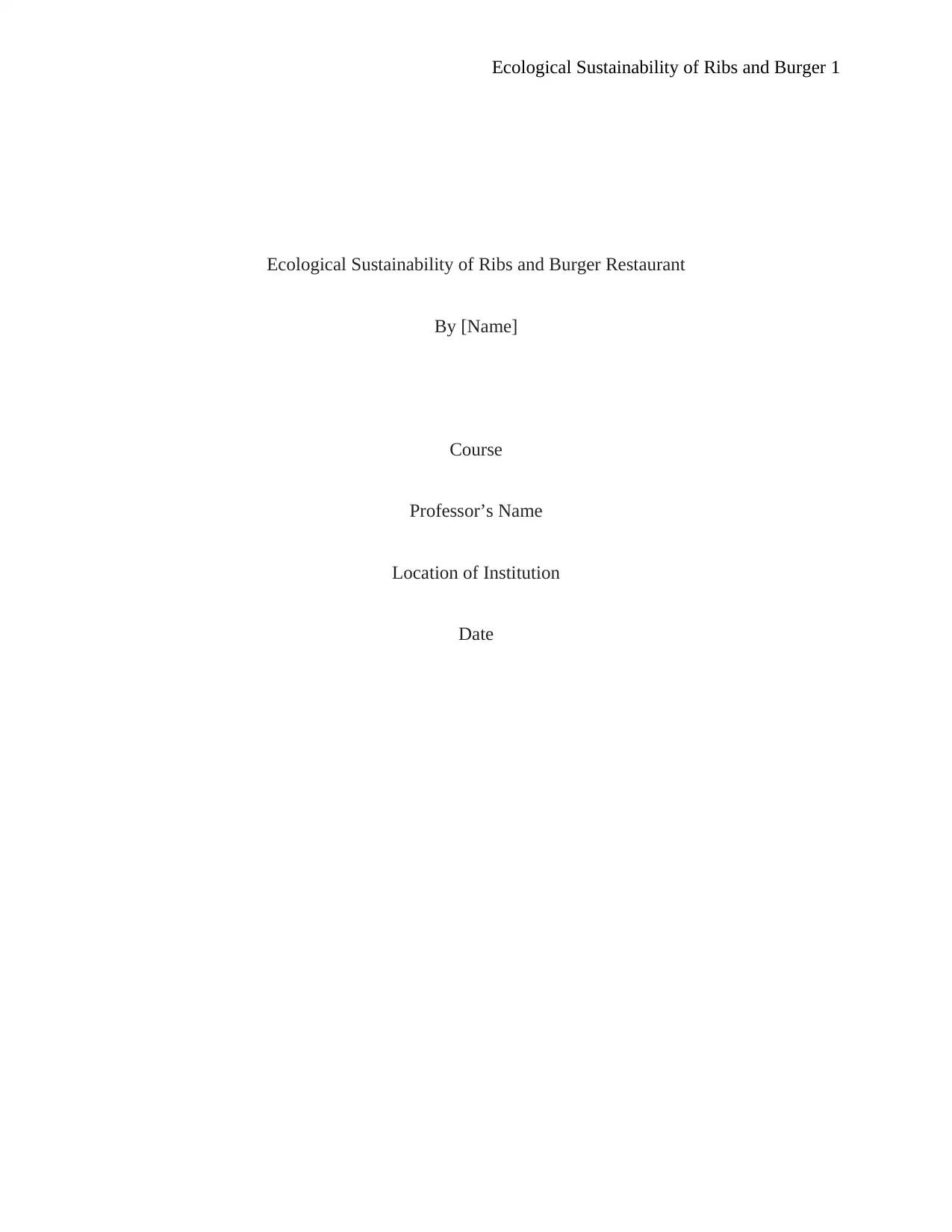
Ecological Sustainability of Ribs and Burger 1
Ecological Sustainability of Ribs and Burger Restaurant
By [Name]
Course
Professor’s Name
Location of Institution
Date
Ecological Sustainability of Ribs and Burger Restaurant
By [Name]
Course
Professor’s Name
Location of Institution
Date
Paraphrase This Document
Need a fresh take? Get an instant paraphrase of this document with our AI Paraphraser
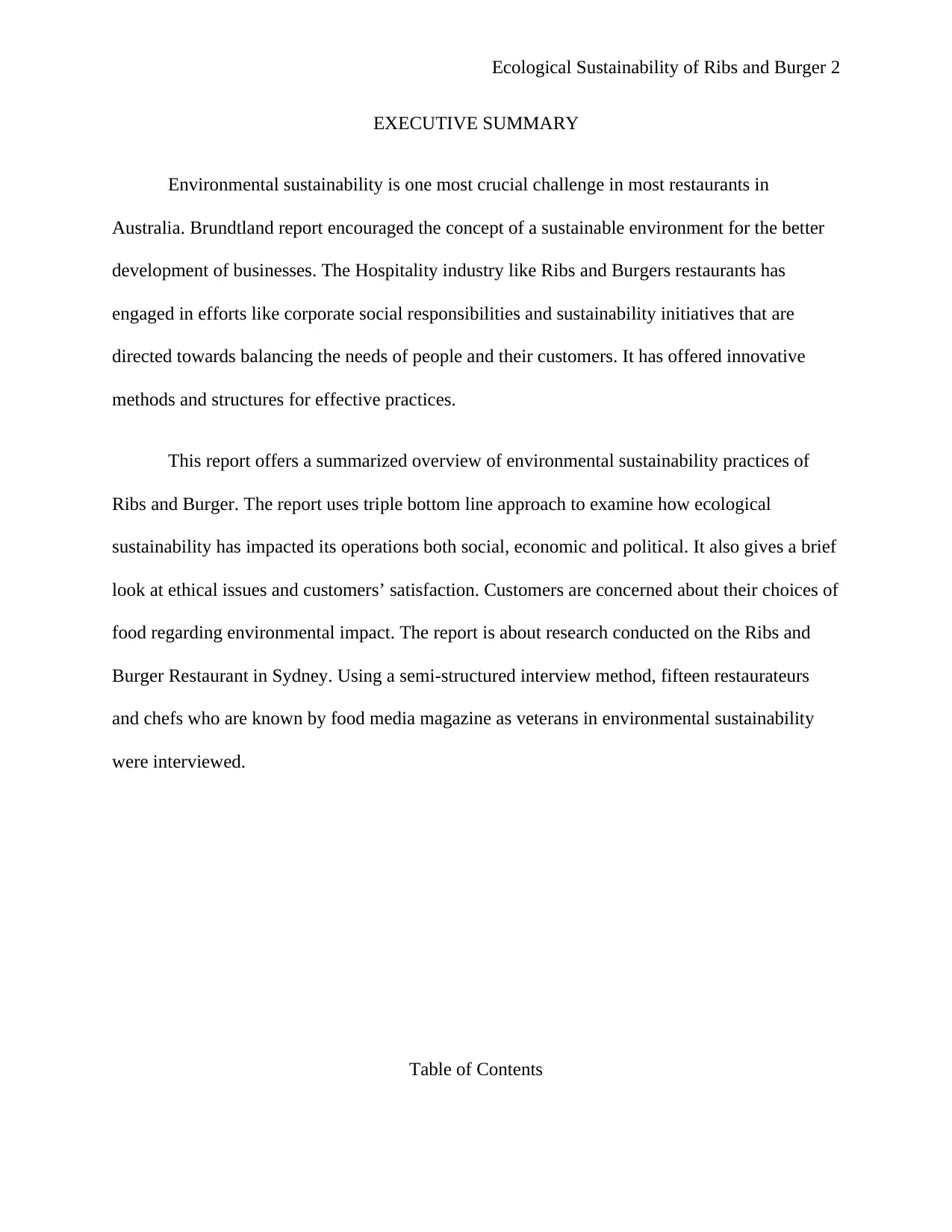
Ecological Sustainability of Ribs and Burger 2
EXECUTIVE SUMMARY
Environmental sustainability is one most crucial challenge in most restaurants in
Australia. Brundtland report encouraged the concept of a sustainable environment for the better
development of businesses. The Hospitality industry like Ribs and Burgers restaurants has
engaged in efforts like corporate social responsibilities and sustainability initiatives that are
directed towards balancing the needs of people and their customers. It has offered innovative
methods and structures for effective practices.
This report offers a summarized overview of environmental sustainability practices of
Ribs and Burger. The report uses triple bottom line approach to examine how ecological
sustainability has impacted its operations both social, economic and political. It also gives a brief
look at ethical issues and customers’ satisfaction. Customers are concerned about their choices of
food regarding environmental impact. The report is about research conducted on the Ribs and
Burger Restaurant in Sydney. Using a semi-structured interview method, fifteen restaurateurs
and chefs who are known by food media magazine as veterans in environmental sustainability
were interviewed.
Table of Contents
EXECUTIVE SUMMARY
Environmental sustainability is one most crucial challenge in most restaurants in
Australia. Brundtland report encouraged the concept of a sustainable environment for the better
development of businesses. The Hospitality industry like Ribs and Burgers restaurants has
engaged in efforts like corporate social responsibilities and sustainability initiatives that are
directed towards balancing the needs of people and their customers. It has offered innovative
methods and structures for effective practices.
This report offers a summarized overview of environmental sustainability practices of
Ribs and Burger. The report uses triple bottom line approach to examine how ecological
sustainability has impacted its operations both social, economic and political. It also gives a brief
look at ethical issues and customers’ satisfaction. Customers are concerned about their choices of
food regarding environmental impact. The report is about research conducted on the Ribs and
Burger Restaurant in Sydney. Using a semi-structured interview method, fifteen restaurateurs
and chefs who are known by food media magazine as veterans in environmental sustainability
were interviewed.
Table of Contents
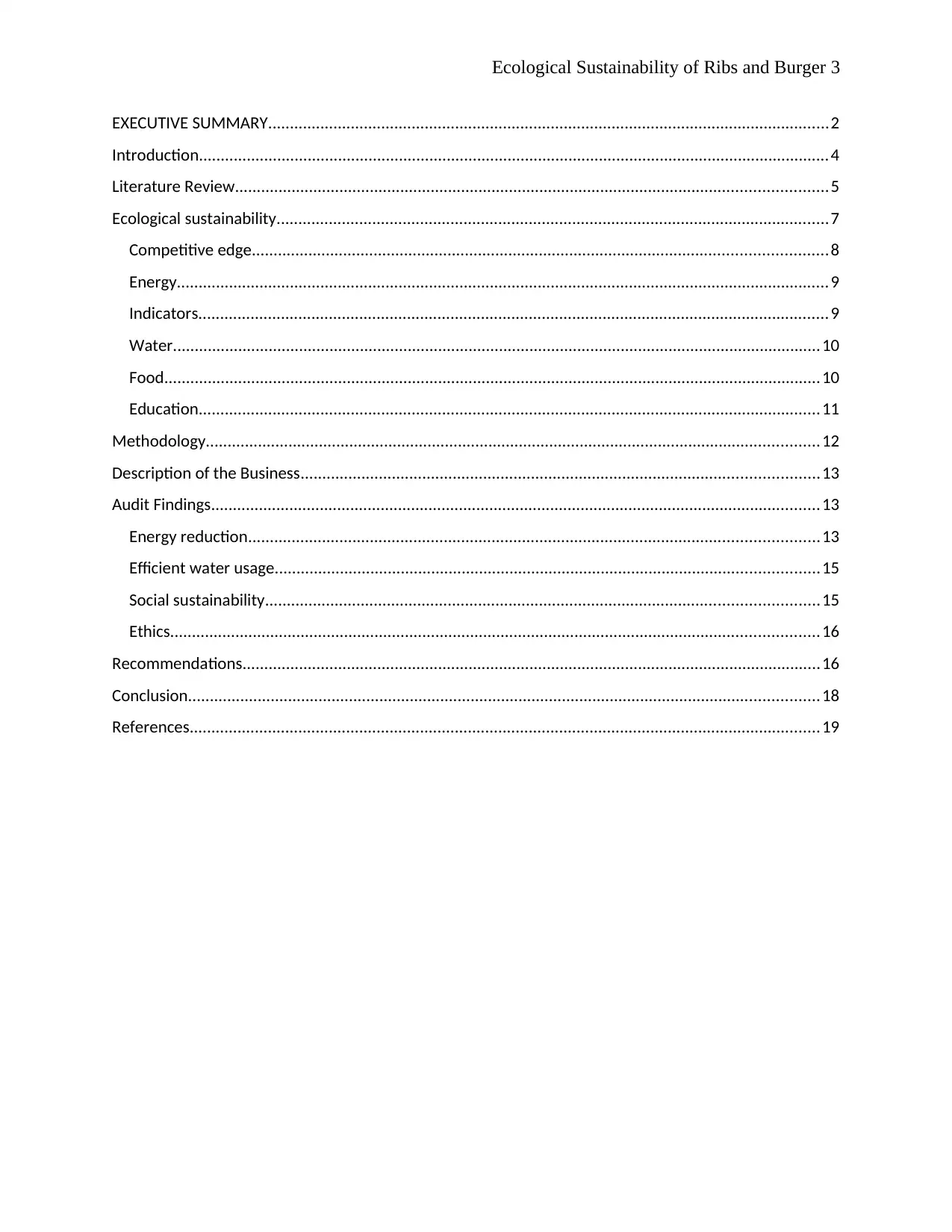
Ecological Sustainability of Ribs and Burger 3
EXECUTIVE SUMMARY.................................................................................................................................2
Introduction.................................................................................................................................................4
Literature Review........................................................................................................................................5
Ecological sustainability...............................................................................................................................7
Competitive edge....................................................................................................................................8
Energy......................................................................................................................................................9
Indicators.................................................................................................................................................9
Water.....................................................................................................................................................10
Food.......................................................................................................................................................10
Education...............................................................................................................................................11
Methodology.............................................................................................................................................12
Description of the Business.......................................................................................................................13
Audit Findings............................................................................................................................................13
Energy reduction...................................................................................................................................13
Efficient water usage.............................................................................................................................15
Social sustainability...............................................................................................................................15
Ethics.....................................................................................................................................................16
Recommendations.....................................................................................................................................16
Conclusion.................................................................................................................................................18
References.................................................................................................................................................19
EXECUTIVE SUMMARY.................................................................................................................................2
Introduction.................................................................................................................................................4
Literature Review........................................................................................................................................5
Ecological sustainability...............................................................................................................................7
Competitive edge....................................................................................................................................8
Energy......................................................................................................................................................9
Indicators.................................................................................................................................................9
Water.....................................................................................................................................................10
Food.......................................................................................................................................................10
Education...............................................................................................................................................11
Methodology.............................................................................................................................................12
Description of the Business.......................................................................................................................13
Audit Findings............................................................................................................................................13
Energy reduction...................................................................................................................................13
Efficient water usage.............................................................................................................................15
Social sustainability...............................................................................................................................15
Ethics.....................................................................................................................................................16
Recommendations.....................................................................................................................................16
Conclusion.................................................................................................................................................18
References.................................................................................................................................................19
⊘ This is a preview!⊘
Do you want full access?
Subscribe today to unlock all pages.

Trusted by 1+ million students worldwide
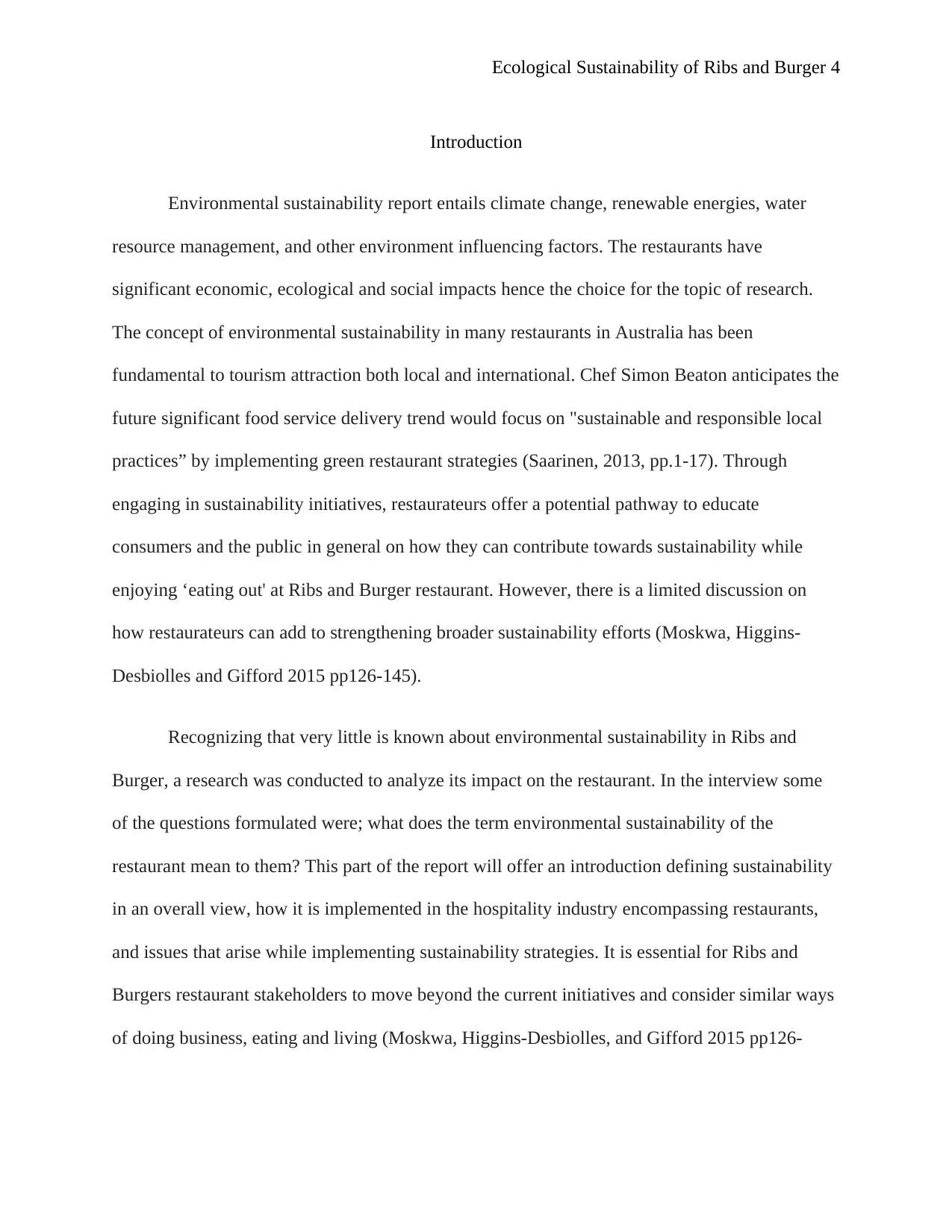
Ecological Sustainability of Ribs and Burger 4
Introduction
Environmental sustainability report entails climate change, renewable energies, water
resource management, and other environment influencing factors. The restaurants have
significant economic, ecological and social impacts hence the choice for the topic of research.
The concept of environmental sustainability in many restaurants in Australia has been
fundamental to tourism attraction both local and international. Chef Simon Beaton anticipates the
future significant food service delivery trend would focus on "sustainable and responsible local
practices” by implementing green restaurant strategies (Saarinen, 2013, pp.1-17). Through
engaging in sustainability initiatives, restaurateurs offer a potential pathway to educate
consumers and the public in general on how they can contribute towards sustainability while
enjoying ‘eating out' at Ribs and Burger restaurant. However, there is a limited discussion on
how restaurateurs can add to strengthening broader sustainability efforts (Moskwa, Higgins-
Desbiolles and Gifford 2015 pp126-145).
Recognizing that very little is known about environmental sustainability in Ribs and
Burger, a research was conducted to analyze its impact on the restaurant. In the interview some
of the questions formulated were; what does the term environmental sustainability of the
restaurant mean to them? This part of the report will offer an introduction defining sustainability
in an overall view, how it is implemented in the hospitality industry encompassing restaurants,
and issues that arise while implementing sustainability strategies. It is essential for Ribs and
Burgers restaurant stakeholders to move beyond the current initiatives and consider similar ways
of doing business, eating and living (Moskwa, Higgins-Desbiolles, and Gifford 2015 pp126-
Introduction
Environmental sustainability report entails climate change, renewable energies, water
resource management, and other environment influencing factors. The restaurants have
significant economic, ecological and social impacts hence the choice for the topic of research.
The concept of environmental sustainability in many restaurants in Australia has been
fundamental to tourism attraction both local and international. Chef Simon Beaton anticipates the
future significant food service delivery trend would focus on "sustainable and responsible local
practices” by implementing green restaurant strategies (Saarinen, 2013, pp.1-17). Through
engaging in sustainability initiatives, restaurateurs offer a potential pathway to educate
consumers and the public in general on how they can contribute towards sustainability while
enjoying ‘eating out' at Ribs and Burger restaurant. However, there is a limited discussion on
how restaurateurs can add to strengthening broader sustainability efforts (Moskwa, Higgins-
Desbiolles and Gifford 2015 pp126-145).
Recognizing that very little is known about environmental sustainability in Ribs and
Burger, a research was conducted to analyze its impact on the restaurant. In the interview some
of the questions formulated were; what does the term environmental sustainability of the
restaurant mean to them? This part of the report will offer an introduction defining sustainability
in an overall view, how it is implemented in the hospitality industry encompassing restaurants,
and issues that arise while implementing sustainability strategies. It is essential for Ribs and
Burgers restaurant stakeholders to move beyond the current initiatives and consider similar ways
of doing business, eating and living (Moskwa, Higgins-Desbiolles, and Gifford 2015 pp126-
Paraphrase This Document
Need a fresh take? Get an instant paraphrase of this document with our AI Paraphraser
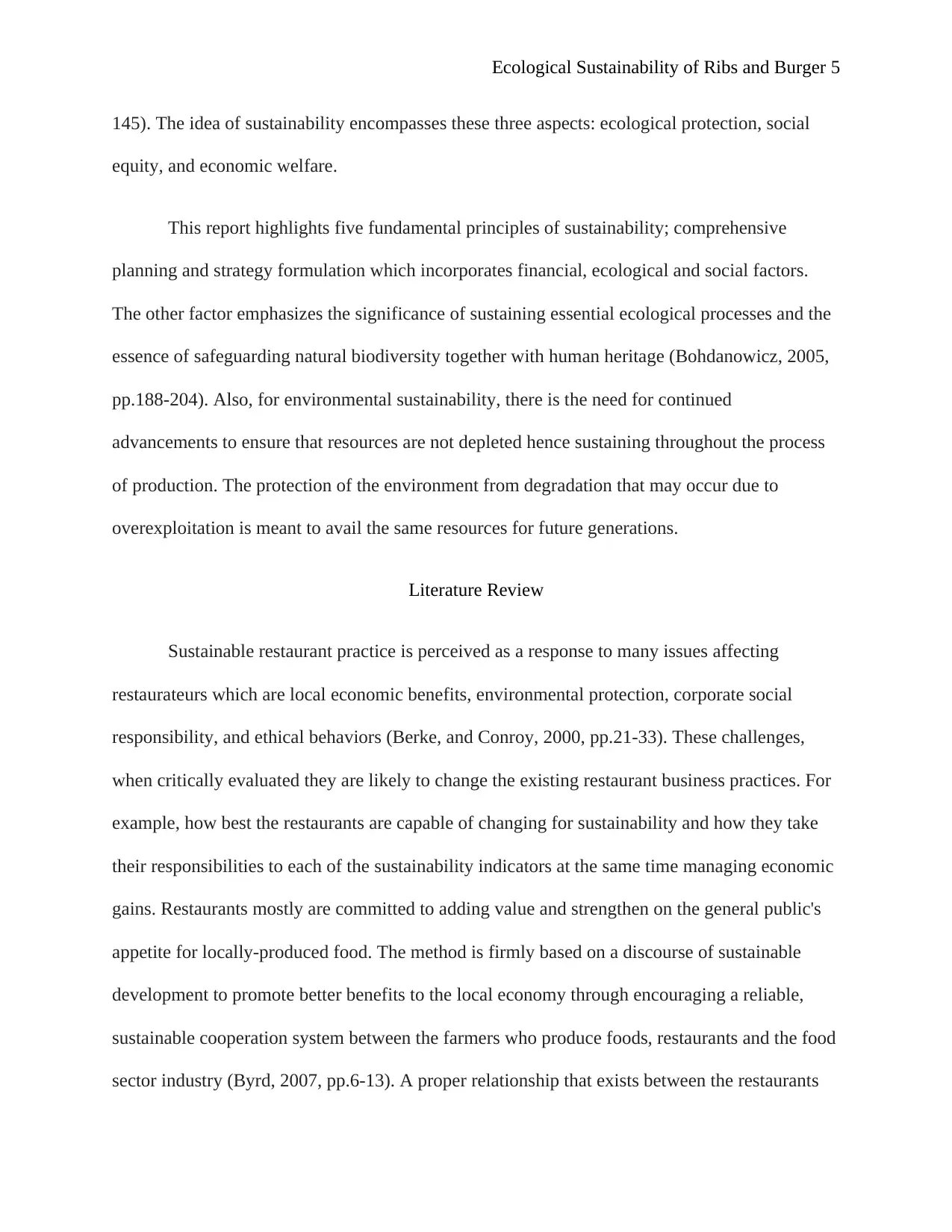
Ecological Sustainability of Ribs and Burger 5
145). The idea of sustainability encompasses these three aspects: ecological protection, social
equity, and economic welfare.
This report highlights five fundamental principles of sustainability; comprehensive
planning and strategy formulation which incorporates financial, ecological and social factors.
The other factor emphasizes the significance of sustaining essential ecological processes and the
essence of safeguarding natural biodiversity together with human heritage (Bohdanowicz, 2005,
pp.188-204). Also, for environmental sustainability, there is the need for continued
advancements to ensure that resources are not depleted hence sustaining throughout the process
of production. The protection of the environment from degradation that may occur due to
overexploitation is meant to avail the same resources for future generations.
Literature Review
Sustainable restaurant practice is perceived as a response to many issues affecting
restaurateurs which are local economic benefits, environmental protection, corporate social
responsibility, and ethical behaviors (Berke, and Conroy, 2000, pp.21-33). These challenges,
when critically evaluated they are likely to change the existing restaurant business practices. For
example, how best the restaurants are capable of changing for sustainability and how they take
their responsibilities to each of the sustainability indicators at the same time managing economic
gains. Restaurants mostly are committed to adding value and strengthen on the general public's
appetite for locally-produced food. The method is firmly based on a discourse of sustainable
development to promote better benefits to the local economy through encouraging a reliable,
sustainable cooperation system between the farmers who produce foods, restaurants and the food
sector industry (Byrd, 2007, pp.6-13). A proper relationship that exists between the restaurants
145). The idea of sustainability encompasses these three aspects: ecological protection, social
equity, and economic welfare.
This report highlights five fundamental principles of sustainability; comprehensive
planning and strategy formulation which incorporates financial, ecological and social factors.
The other factor emphasizes the significance of sustaining essential ecological processes and the
essence of safeguarding natural biodiversity together with human heritage (Bohdanowicz, 2005,
pp.188-204). Also, for environmental sustainability, there is the need for continued
advancements to ensure that resources are not depleted hence sustaining throughout the process
of production. The protection of the environment from degradation that may occur due to
overexploitation is meant to avail the same resources for future generations.
Literature Review
Sustainable restaurant practice is perceived as a response to many issues affecting
restaurateurs which are local economic benefits, environmental protection, corporate social
responsibility, and ethical behaviors (Berke, and Conroy, 2000, pp.21-33). These challenges,
when critically evaluated they are likely to change the existing restaurant business practices. For
example, how best the restaurants are capable of changing for sustainability and how they take
their responsibilities to each of the sustainability indicators at the same time managing economic
gains. Restaurants mostly are committed to adding value and strengthen on the general public's
appetite for locally-produced food. The method is firmly based on a discourse of sustainable
development to promote better benefits to the local economy through encouraging a reliable,
sustainable cooperation system between the farmers who produce foods, restaurants and the food
sector industry (Byrd, 2007, pp.6-13). A proper relationship that exists between the restaurants
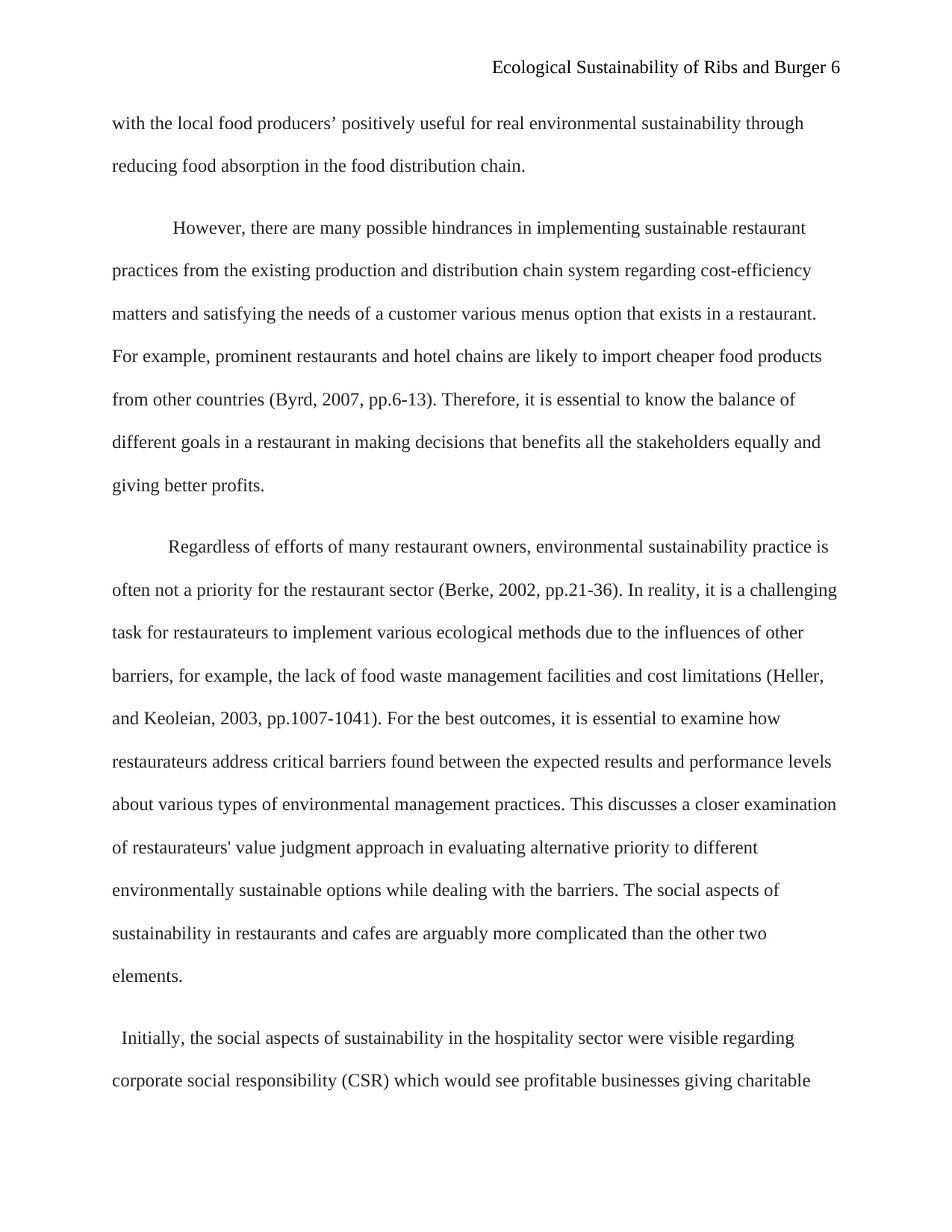
Ecological Sustainability of Ribs and Burger 6
with the local food producers’ positively useful for real environmental sustainability through
reducing food absorption in the food distribution chain.
However, there are many possible hindrances in implementing sustainable restaurant
practices from the existing production and distribution chain system regarding cost-efficiency
matters and satisfying the needs of a customer various menus option that exists in a restaurant.
For example, prominent restaurants and hotel chains are likely to import cheaper food products
from other countries (Byrd, 2007, pp.6-13). Therefore, it is essential to know the balance of
different goals in a restaurant in making decisions that benefits all the stakeholders equally and
giving better profits.
Regardless of efforts of many restaurant owners, environmental sustainability practice is
often not a priority for the restaurant sector (Berke, 2002, pp.21-36). In reality, it is a challenging
task for restaurateurs to implement various ecological methods due to the influences of other
barriers, for example, the lack of food waste management facilities and cost limitations (Heller,
and Keoleian, 2003, pp.1007-1041). For the best outcomes, it is essential to examine how
restaurateurs address critical barriers found between the expected results and performance levels
about various types of environmental management practices. This discusses a closer examination
of restaurateurs' value judgment approach in evaluating alternative priority to different
environmentally sustainable options while dealing with the barriers. The social aspects of
sustainability in restaurants and cafes are arguably more complicated than the other two
elements.
Initially, the social aspects of sustainability in the hospitality sector were visible regarding
corporate social responsibility (CSR) which would see profitable businesses giving charitable
with the local food producers’ positively useful for real environmental sustainability through
reducing food absorption in the food distribution chain.
However, there are many possible hindrances in implementing sustainable restaurant
practices from the existing production and distribution chain system regarding cost-efficiency
matters and satisfying the needs of a customer various menus option that exists in a restaurant.
For example, prominent restaurants and hotel chains are likely to import cheaper food products
from other countries (Byrd, 2007, pp.6-13). Therefore, it is essential to know the balance of
different goals in a restaurant in making decisions that benefits all the stakeholders equally and
giving better profits.
Regardless of efforts of many restaurant owners, environmental sustainability practice is
often not a priority for the restaurant sector (Berke, 2002, pp.21-36). In reality, it is a challenging
task for restaurateurs to implement various ecological methods due to the influences of other
barriers, for example, the lack of food waste management facilities and cost limitations (Heller,
and Keoleian, 2003, pp.1007-1041). For the best outcomes, it is essential to examine how
restaurateurs address critical barriers found between the expected results and performance levels
about various types of environmental management practices. This discusses a closer examination
of restaurateurs' value judgment approach in evaluating alternative priority to different
environmentally sustainable options while dealing with the barriers. The social aspects of
sustainability in restaurants and cafes are arguably more complicated than the other two
elements.
Initially, the social aspects of sustainability in the hospitality sector were visible regarding
corporate social responsibility (CSR) which would see profitable businesses giving charitable
⊘ This is a preview!⊘
Do you want full access?
Subscribe today to unlock all pages.

Trusted by 1+ million students worldwide
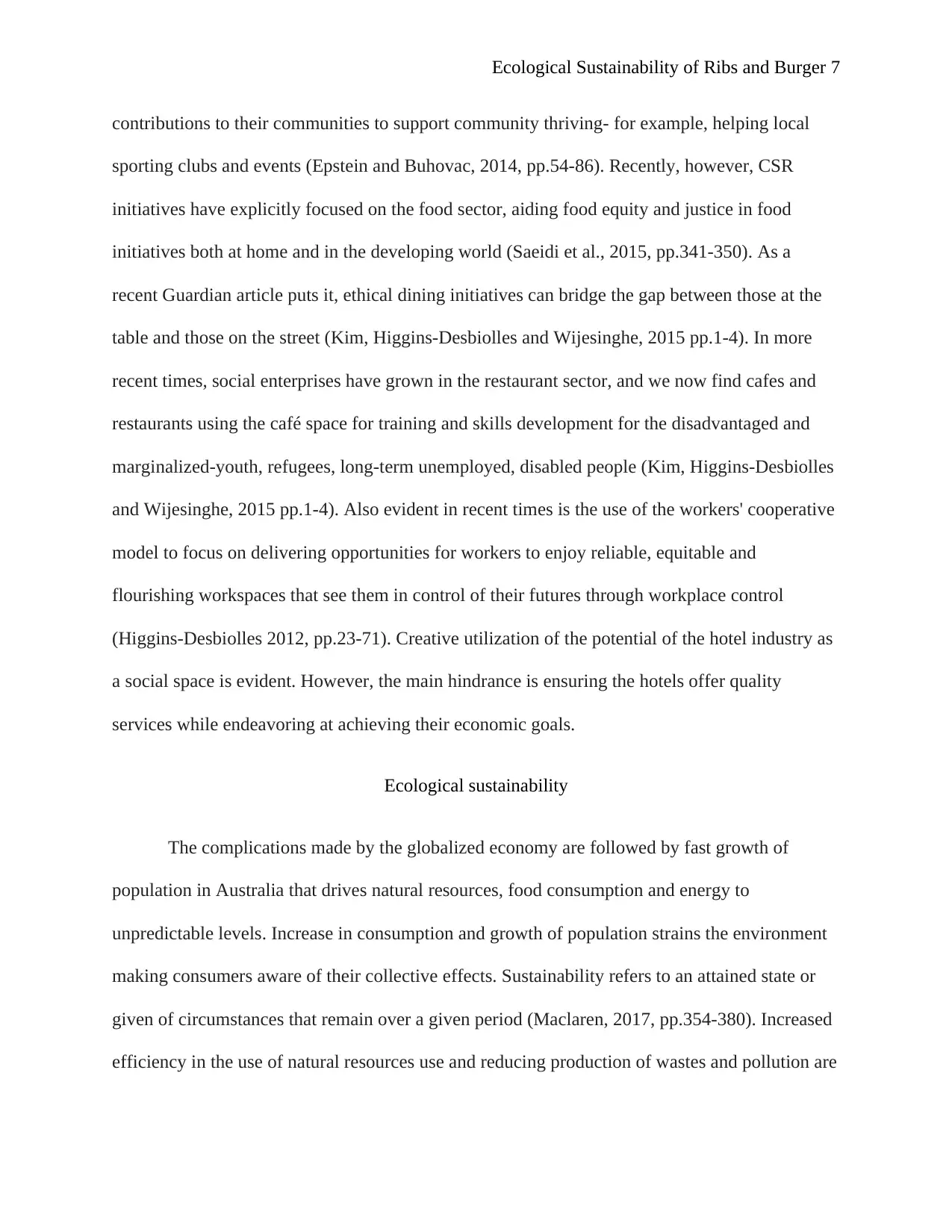
Ecological Sustainability of Ribs and Burger 7
contributions to their communities to support community thriving- for example, helping local
sporting clubs and events (Epstein and Buhovac, 2014, pp.54-86). Recently, however, CSR
initiatives have explicitly focused on the food sector, aiding food equity and justice in food
initiatives both at home and in the developing world (Saeidi et al., 2015, pp.341-350). As a
recent Guardian article puts it, ethical dining initiatives can bridge the gap between those at the
table and those on the street (Kim, Higgins-Desbiolles and Wijesinghe, 2015 pp.1-4). In more
recent times, social enterprises have grown in the restaurant sector, and we now find cafes and
restaurants using the café space for training and skills development for the disadvantaged and
marginalized-youth, refugees, long-term unemployed, disabled people (Kim, Higgins-Desbiolles
and Wijesinghe, 2015 pp.1-4). Also evident in recent times is the use of the workers' cooperative
model to focus on delivering opportunities for workers to enjoy reliable, equitable and
flourishing workspaces that see them in control of their futures through workplace control
(Higgins-Desbiolles 2012, pp.23-71). Creative utilization of the potential of the hotel industry as
a social space is evident. However, the main hindrance is ensuring the hotels offer quality
services while endeavoring at achieving their economic goals.
Ecological sustainability
The complications made by the globalized economy are followed by fast growth of
population in Australia that drives natural resources, food consumption and energy to
unpredictable levels. Increase in consumption and growth of population strains the environment
making consumers aware of their collective effects. Sustainability refers to an attained state or
given of circumstances that remain over a given period (Maclaren, 2017, pp.354-380). Increased
efficiency in the use of natural resources use and reducing production of wastes and pollution are
contributions to their communities to support community thriving- for example, helping local
sporting clubs and events (Epstein and Buhovac, 2014, pp.54-86). Recently, however, CSR
initiatives have explicitly focused on the food sector, aiding food equity and justice in food
initiatives both at home and in the developing world (Saeidi et al., 2015, pp.341-350). As a
recent Guardian article puts it, ethical dining initiatives can bridge the gap between those at the
table and those on the street (Kim, Higgins-Desbiolles and Wijesinghe, 2015 pp.1-4). In more
recent times, social enterprises have grown in the restaurant sector, and we now find cafes and
restaurants using the café space for training and skills development for the disadvantaged and
marginalized-youth, refugees, long-term unemployed, disabled people (Kim, Higgins-Desbiolles
and Wijesinghe, 2015 pp.1-4). Also evident in recent times is the use of the workers' cooperative
model to focus on delivering opportunities for workers to enjoy reliable, equitable and
flourishing workspaces that see them in control of their futures through workplace control
(Higgins-Desbiolles 2012, pp.23-71). Creative utilization of the potential of the hotel industry as
a social space is evident. However, the main hindrance is ensuring the hotels offer quality
services while endeavoring at achieving their economic goals.
Ecological sustainability
The complications made by the globalized economy are followed by fast growth of
population in Australia that drives natural resources, food consumption and energy to
unpredictable levels. Increase in consumption and growth of population strains the environment
making consumers aware of their collective effects. Sustainability refers to an attained state or
given of circumstances that remain over a given period (Maclaren, 2017, pp.354-380). Increased
efficiency in the use of natural resources use and reducing production of wastes and pollution are
Paraphrase This Document
Need a fresh take? Get an instant paraphrase of this document with our AI Paraphraser
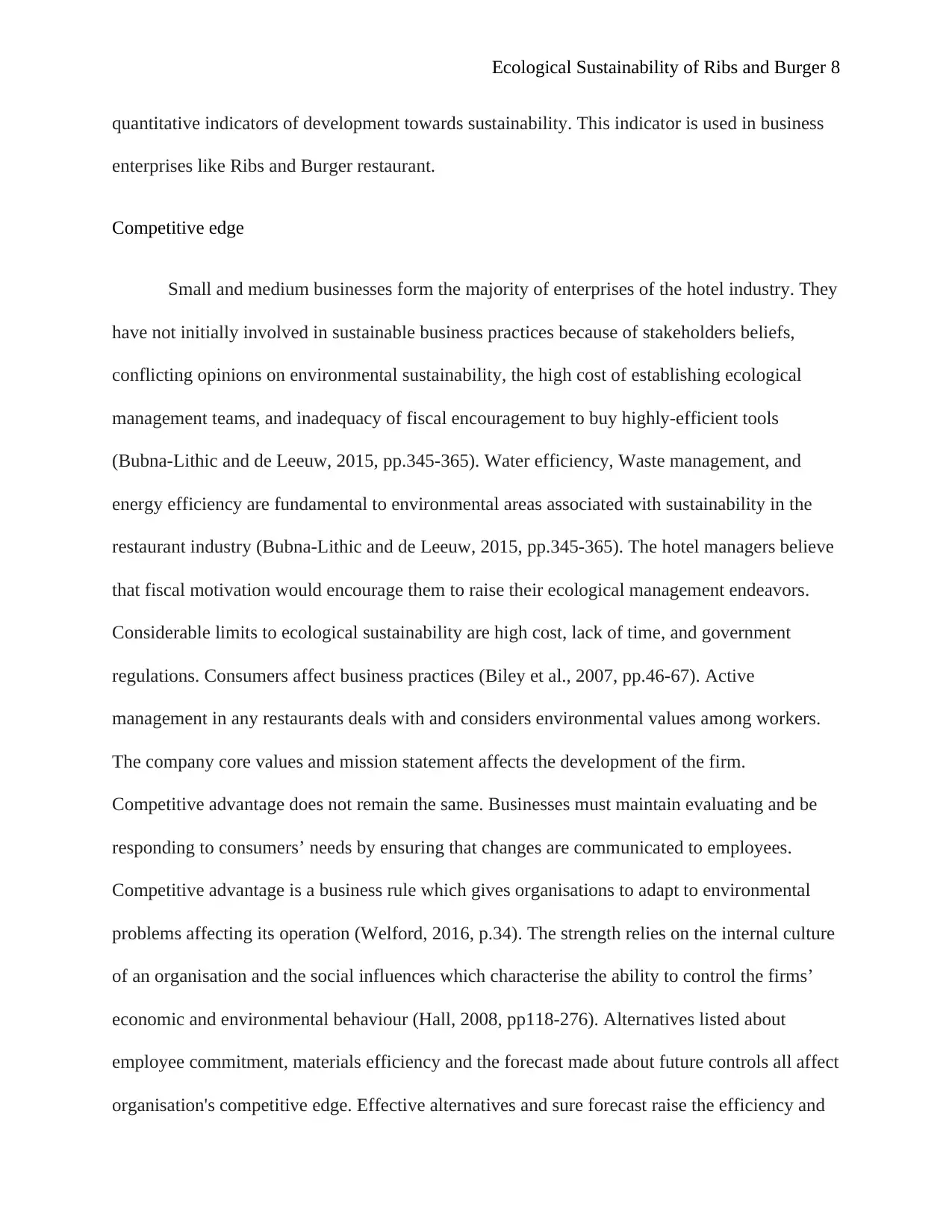
Ecological Sustainability of Ribs and Burger 8
quantitative indicators of development towards sustainability. This indicator is used in business
enterprises like Ribs and Burger restaurant.
Competitive edge
Small and medium businesses form the majority of enterprises of the hotel industry. They
have not initially involved in sustainable business practices because of stakeholders beliefs,
conflicting opinions on environmental sustainability, the high cost of establishing ecological
management teams, and inadequacy of fiscal encouragement to buy highly-efficient tools
(Bubna-Lithic and de Leeuw, 2015, pp.345-365). Water efficiency, Waste management, and
energy efficiency are fundamental to environmental areas associated with sustainability in the
restaurant industry (Bubna-Lithic and de Leeuw, 2015, pp.345-365). The hotel managers believe
that fiscal motivation would encourage them to raise their ecological management endeavors.
Considerable limits to ecological sustainability are high cost, lack of time, and government
regulations. Consumers affect business practices (Biley et al., 2007, pp.46-67). Active
management in any restaurants deals with and considers environmental values among workers.
The company core values and mission statement affects the development of the firm.
Competitive advantage does not remain the same. Businesses must maintain evaluating and be
responding to consumers’ needs by ensuring that changes are communicated to employees.
Competitive advantage is a business rule which gives organisations to adapt to environmental
problems affecting its operation (Welford, 2016, p.34). The strength relies on the internal culture
of an organisation and the social influences which characterise the ability to control the firms’
economic and environmental behaviour (Hall, 2008, pp118-276). Alternatives listed about
employee commitment, materials efficiency and the forecast made about future controls all affect
organisation's competitive edge. Effective alternatives and sure forecast raise the efficiency and
quantitative indicators of development towards sustainability. This indicator is used in business
enterprises like Ribs and Burger restaurant.
Competitive edge
Small and medium businesses form the majority of enterprises of the hotel industry. They
have not initially involved in sustainable business practices because of stakeholders beliefs,
conflicting opinions on environmental sustainability, the high cost of establishing ecological
management teams, and inadequacy of fiscal encouragement to buy highly-efficient tools
(Bubna-Lithic and de Leeuw, 2015, pp.345-365). Water efficiency, Waste management, and
energy efficiency are fundamental to environmental areas associated with sustainability in the
restaurant industry (Bubna-Lithic and de Leeuw, 2015, pp.345-365). The hotel managers believe
that fiscal motivation would encourage them to raise their ecological management endeavors.
Considerable limits to ecological sustainability are high cost, lack of time, and government
regulations. Consumers affect business practices (Biley et al., 2007, pp.46-67). Active
management in any restaurants deals with and considers environmental values among workers.
The company core values and mission statement affects the development of the firm.
Competitive advantage does not remain the same. Businesses must maintain evaluating and be
responding to consumers’ needs by ensuring that changes are communicated to employees.
Competitive advantage is a business rule which gives organisations to adapt to environmental
problems affecting its operation (Welford, 2016, p.34). The strength relies on the internal culture
of an organisation and the social influences which characterise the ability to control the firms’
economic and environmental behaviour (Hall, 2008, pp118-276). Alternatives listed about
employee commitment, materials efficiency and the forecast made about future controls all affect
organisation's competitive edge. Effective alternatives and sure forecast raise the efficiency and
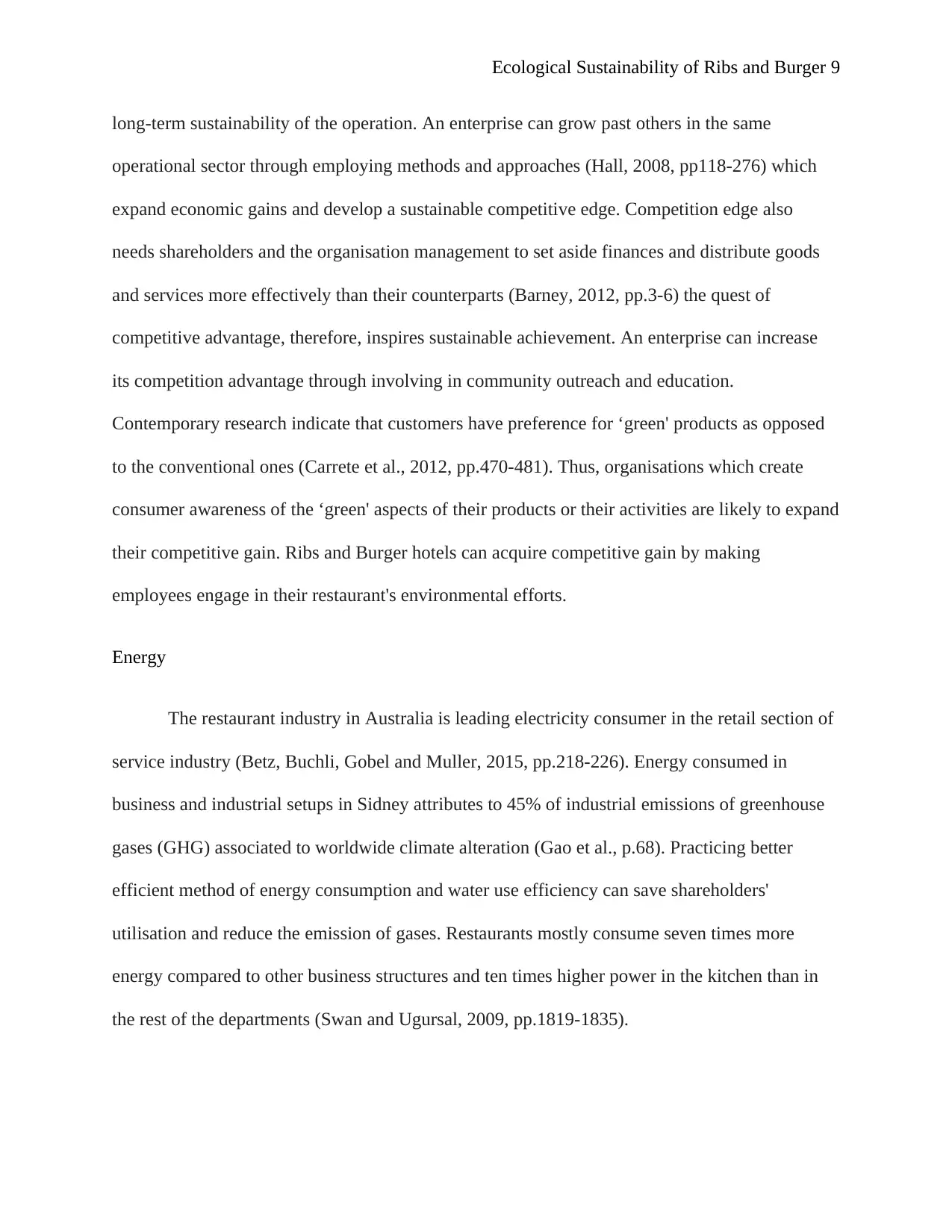
Ecological Sustainability of Ribs and Burger 9
long-term sustainability of the operation. An enterprise can grow past others in the same
operational sector through employing methods and approaches (Hall, 2008, pp118-276) which
expand economic gains and develop a sustainable competitive edge. Competition edge also
needs shareholders and the organisation management to set aside finances and distribute goods
and services more effectively than their counterparts (Barney, 2012, pp.3-6) the quest of
competitive advantage, therefore, inspires sustainable achievement. An enterprise can increase
its competition advantage through involving in community outreach and education.
Contemporary research indicate that customers have preference for ‘green' products as opposed
to the conventional ones (Carrete et al., 2012, pp.470-481). Thus, organisations which create
consumer awareness of the ‘green' aspects of their products or their activities are likely to expand
their competitive gain. Ribs and Burger hotels can acquire competitive gain by making
employees engage in their restaurant's environmental efforts.
Energy
The restaurant industry in Australia is leading electricity consumer in the retail section of
service industry (Betz, Buchli, Gobel and Muller, 2015, pp.218-226). Energy consumed in
business and industrial setups in Sidney attributes to 45% of industrial emissions of greenhouse
gases (GHG) associated to worldwide climate alteration (Gao et al., p.68). Practicing better
efficient method of energy consumption and water use efficiency can save shareholders'
utilisation and reduce the emission of gases. Restaurants mostly consume seven times more
energy compared to other business structures and ten times higher power in the kitchen than in
the rest of the departments (Swan and Ugursal, 2009, pp.1819-1835).
long-term sustainability of the operation. An enterprise can grow past others in the same
operational sector through employing methods and approaches (Hall, 2008, pp118-276) which
expand economic gains and develop a sustainable competitive edge. Competition edge also
needs shareholders and the organisation management to set aside finances and distribute goods
and services more effectively than their counterparts (Barney, 2012, pp.3-6) the quest of
competitive advantage, therefore, inspires sustainable achievement. An enterprise can increase
its competition advantage through involving in community outreach and education.
Contemporary research indicate that customers have preference for ‘green' products as opposed
to the conventional ones (Carrete et al., 2012, pp.470-481). Thus, organisations which create
consumer awareness of the ‘green' aspects of their products or their activities are likely to expand
their competitive gain. Ribs and Burger hotels can acquire competitive gain by making
employees engage in their restaurant's environmental efforts.
Energy
The restaurant industry in Australia is leading electricity consumer in the retail section of
service industry (Betz, Buchli, Gobel and Muller, 2015, pp.218-226). Energy consumed in
business and industrial setups in Sidney attributes to 45% of industrial emissions of greenhouse
gases (GHG) associated to worldwide climate alteration (Gao et al., p.68). Practicing better
efficient method of energy consumption and water use efficiency can save shareholders'
utilisation and reduce the emission of gases. Restaurants mostly consume seven times more
energy compared to other business structures and ten times higher power in the kitchen than in
the rest of the departments (Swan and Ugursal, 2009, pp.1819-1835).
⊘ This is a preview!⊘
Do you want full access?
Subscribe today to unlock all pages.

Trusted by 1+ million students worldwide
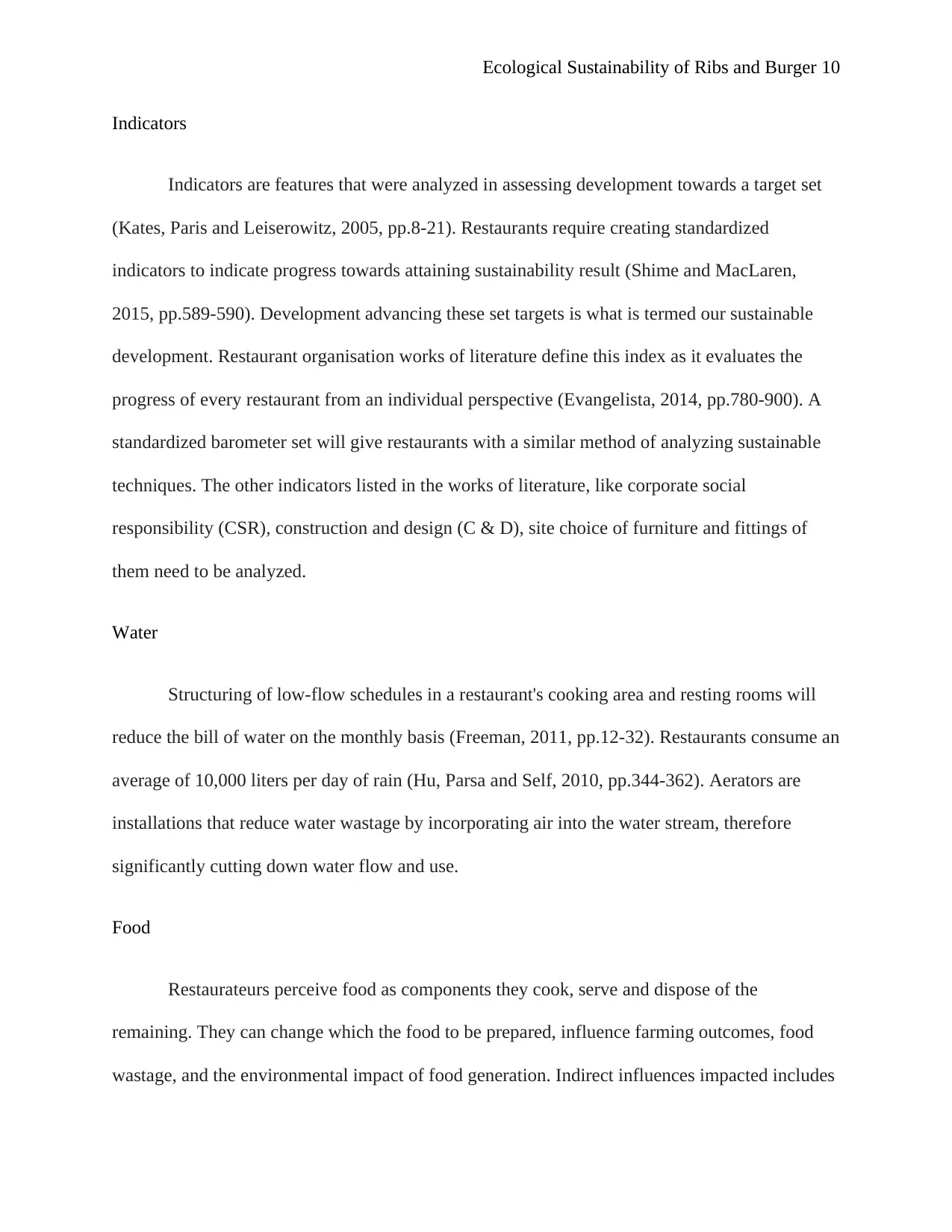
Ecological Sustainability of Ribs and Burger 10
Indicators
Indicators are features that were analyzed in assessing development towards a target set
(Kates, Paris and Leiserowitz, 2005, pp.8-21). Restaurants require creating standardized
indicators to indicate progress towards attaining sustainability result (Shime and MacLaren,
2015, pp.589-590). Development advancing these set targets is what is termed our sustainable
development. Restaurant organisation works of literature define this index as it evaluates the
progress of every restaurant from an individual perspective (Evangelista, 2014, pp.780-900). A
standardized barometer set will give restaurants with a similar method of analyzing sustainable
techniques. The other indicators listed in the works of literature, like corporate social
responsibility (CSR), construction and design (C & D), site choice of furniture and fittings of
them need to be analyzed.
Water
Structuring of low-flow schedules in a restaurant's cooking area and resting rooms will
reduce the bill of water on the monthly basis (Freeman, 2011, pp.12-32). Restaurants consume an
average of 10,000 liters per day of rain (Hu, Parsa and Self, 2010, pp.344-362). Aerators are
installations that reduce water wastage by incorporating air into the water stream, therefore
significantly cutting down water flow and use.
Food
Restaurateurs perceive food as components they cook, serve and dispose of the
remaining. They can change which the food to be prepared, influence farming outcomes, food
wastage, and the environmental impact of food generation. Indirect influences impacted includes
Indicators
Indicators are features that were analyzed in assessing development towards a target set
(Kates, Paris and Leiserowitz, 2005, pp.8-21). Restaurants require creating standardized
indicators to indicate progress towards attaining sustainability result (Shime and MacLaren,
2015, pp.589-590). Development advancing these set targets is what is termed our sustainable
development. Restaurant organisation works of literature define this index as it evaluates the
progress of every restaurant from an individual perspective (Evangelista, 2014, pp.780-900). A
standardized barometer set will give restaurants with a similar method of analyzing sustainable
techniques. The other indicators listed in the works of literature, like corporate social
responsibility (CSR), construction and design (C & D), site choice of furniture and fittings of
them need to be analyzed.
Water
Structuring of low-flow schedules in a restaurant's cooking area and resting rooms will
reduce the bill of water on the monthly basis (Freeman, 2011, pp.12-32). Restaurants consume an
average of 10,000 liters per day of rain (Hu, Parsa and Self, 2010, pp.344-362). Aerators are
installations that reduce water wastage by incorporating air into the water stream, therefore
significantly cutting down water flow and use.
Food
Restaurateurs perceive food as components they cook, serve and dispose of the
remaining. They can change which the food to be prepared, influence farming outcomes, food
wastage, and the environmental impact of food generation. Indirect influences impacted includes
Paraphrase This Document
Need a fresh take? Get an instant paraphrase of this document with our AI Paraphraser
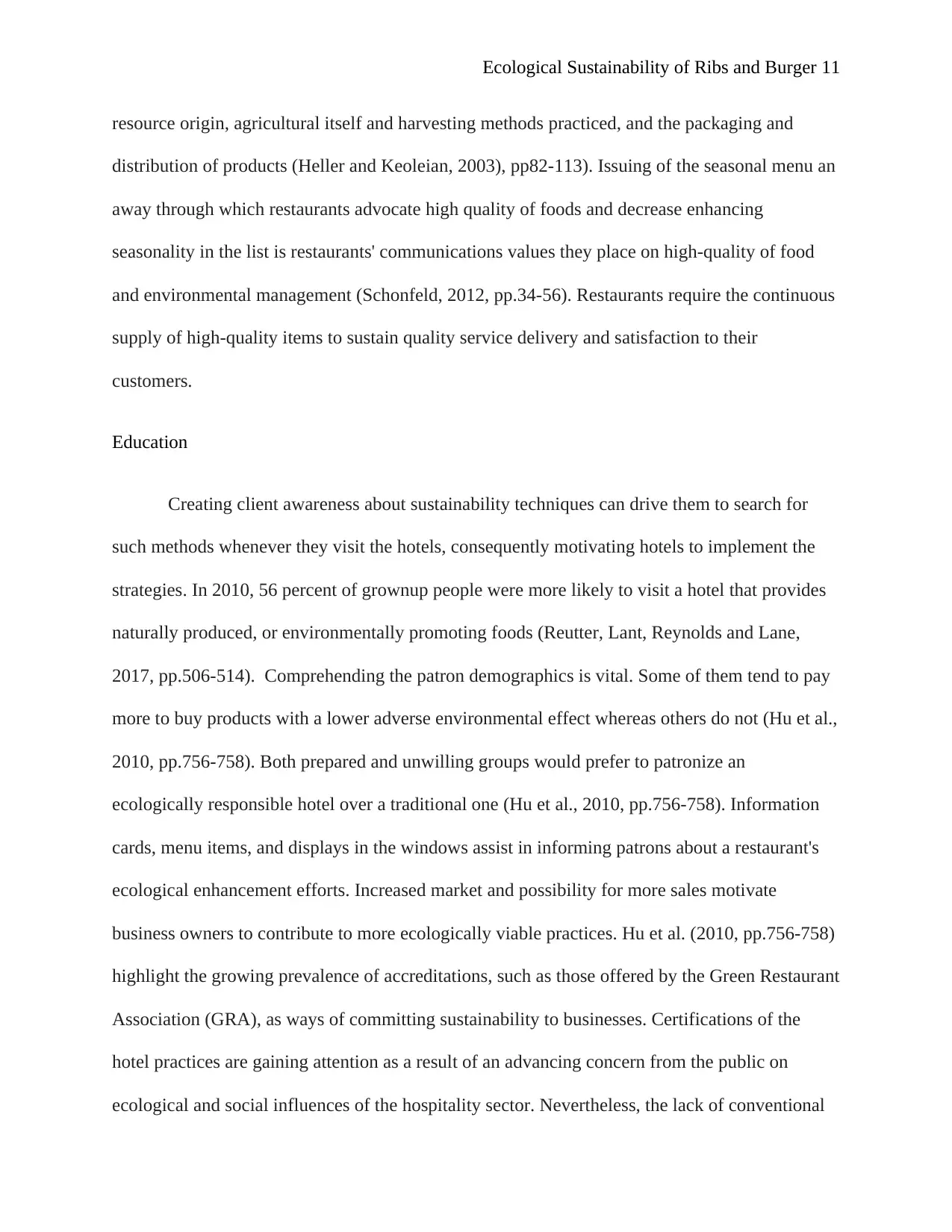
Ecological Sustainability of Ribs and Burger 11
resource origin, agricultural itself and harvesting methods practiced, and the packaging and
distribution of products (Heller and Keoleian, 2003), pp82-113). Issuing of the seasonal menu an
away through which restaurants advocate high quality of foods and decrease enhancing
seasonality in the list is restaurants' communications values they place on high-quality of food
and environmental management (Schonfeld, 2012, pp.34-56). Restaurants require the continuous
supply of high-quality items to sustain quality service delivery and satisfaction to their
customers.
Education
Creating client awareness about sustainability techniques can drive them to search for
such methods whenever they visit the hotels, consequently motivating hotels to implement the
strategies. In 2010, 56 percent of grownup people were more likely to visit a hotel that provides
naturally produced, or environmentally promoting foods (Reutter, Lant, Reynolds and Lane,
2017, pp.506-514). Comprehending the patron demographics is vital. Some of them tend to pay
more to buy products with a lower adverse environmental effect whereas others do not (Hu et al.,
2010, pp.756-758). Both prepared and unwilling groups would prefer to patronize an
ecologically responsible hotel over a traditional one (Hu et al., 2010, pp.756-758). Information
cards, menu items, and displays in the windows assist in informing patrons about a restaurant's
ecological enhancement efforts. Increased market and possibility for more sales motivate
business owners to contribute to more ecologically viable practices. Hu et al. (2010, pp.756-758)
highlight the growing prevalence of accreditations, such as those offered by the Green Restaurant
Association (GRA), as ways of committing sustainability to businesses. Certifications of the
hotel practices are gaining attention as a result of an advancing concern from the public on
ecological and social influences of the hospitality sector. Nevertheless, the lack of conventional
resource origin, agricultural itself and harvesting methods practiced, and the packaging and
distribution of products (Heller and Keoleian, 2003), pp82-113). Issuing of the seasonal menu an
away through which restaurants advocate high quality of foods and decrease enhancing
seasonality in the list is restaurants' communications values they place on high-quality of food
and environmental management (Schonfeld, 2012, pp.34-56). Restaurants require the continuous
supply of high-quality items to sustain quality service delivery and satisfaction to their
customers.
Education
Creating client awareness about sustainability techniques can drive them to search for
such methods whenever they visit the hotels, consequently motivating hotels to implement the
strategies. In 2010, 56 percent of grownup people were more likely to visit a hotel that provides
naturally produced, or environmentally promoting foods (Reutter, Lant, Reynolds and Lane,
2017, pp.506-514). Comprehending the patron demographics is vital. Some of them tend to pay
more to buy products with a lower adverse environmental effect whereas others do not (Hu et al.,
2010, pp.756-758). Both prepared and unwilling groups would prefer to patronize an
ecologically responsible hotel over a traditional one (Hu et al., 2010, pp.756-758). Information
cards, menu items, and displays in the windows assist in informing patrons about a restaurant's
ecological enhancement efforts. Increased market and possibility for more sales motivate
business owners to contribute to more ecologically viable practices. Hu et al. (2010, pp.756-758)
highlight the growing prevalence of accreditations, such as those offered by the Green Restaurant
Association (GRA), as ways of committing sustainability to businesses. Certifications of the
hotel practices are gaining attention as a result of an advancing concern from the public on
ecological and social influences of the hospitality sector. Nevertheless, the lack of conventional
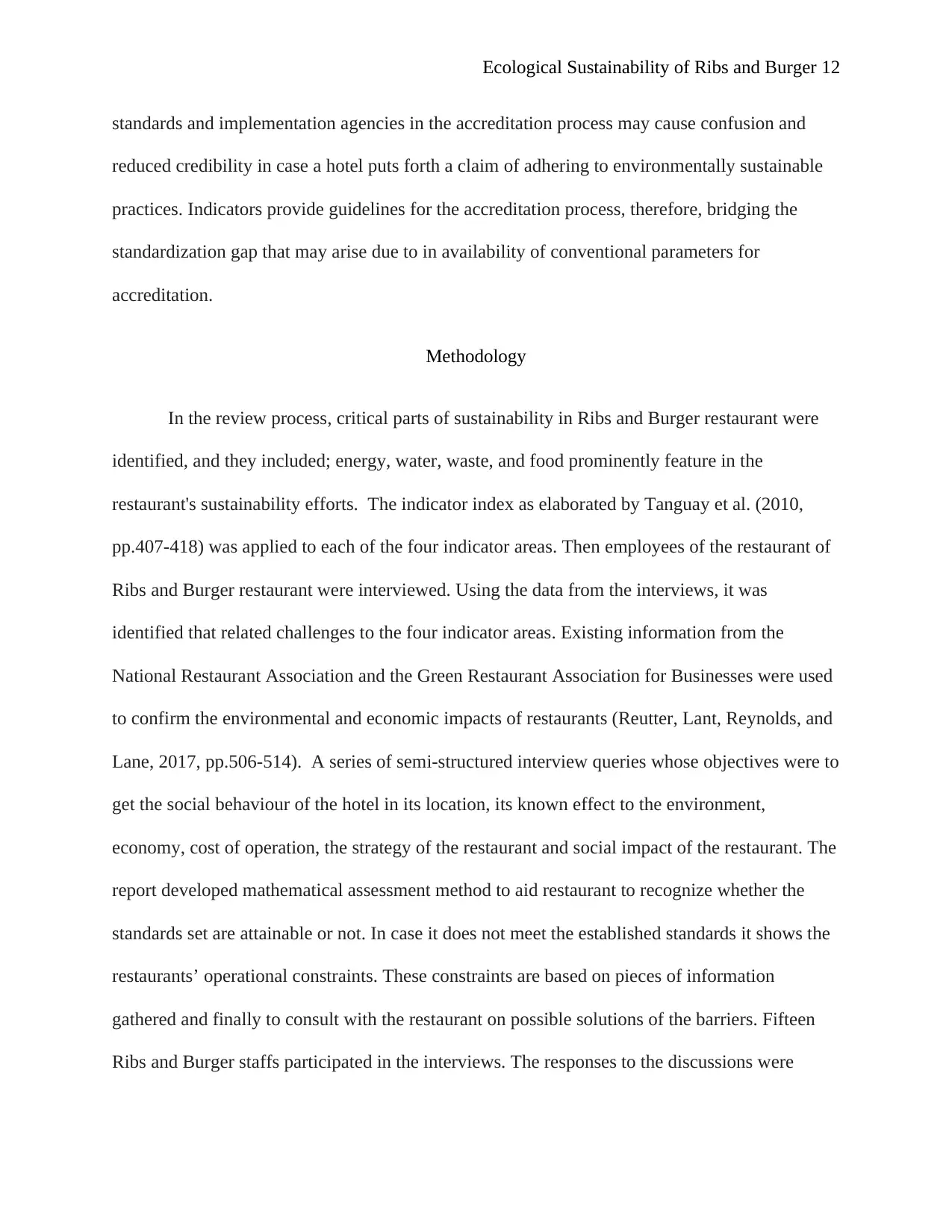
Ecological Sustainability of Ribs and Burger 12
standards and implementation agencies in the accreditation process may cause confusion and
reduced credibility in case a hotel puts forth a claim of adhering to environmentally sustainable
practices. Indicators provide guidelines for the accreditation process, therefore, bridging the
standardization gap that may arise due to in availability of conventional parameters for
accreditation.
Methodology
In the review process, critical parts of sustainability in Ribs and Burger restaurant were
identified, and they included; energy, water, waste, and food prominently feature in the
restaurant's sustainability efforts. The indicator index as elaborated by Tanguay et al. (2010,
pp.407-418) was applied to each of the four indicator areas. Then employees of the restaurant of
Ribs and Burger restaurant were interviewed. Using the data from the interviews, it was
identified that related challenges to the four indicator areas. Existing information from the
National Restaurant Association and the Green Restaurant Association for Businesses were used
to confirm the environmental and economic impacts of restaurants (Reutter, Lant, Reynolds, and
Lane, 2017, pp.506-514). A series of semi-structured interview queries whose objectives were to
get the social behaviour of the hotel in its location, its known effect to the environment,
economy, cost of operation, the strategy of the restaurant and social impact of the restaurant. The
report developed mathematical assessment method to aid restaurant to recognize whether the
standards set are attainable or not. In case it does not meet the established standards it shows the
restaurants’ operational constraints. These constraints are based on pieces of information
gathered and finally to consult with the restaurant on possible solutions of the barriers. Fifteen
Ribs and Burger staffs participated in the interviews. The responses to the discussions were
standards and implementation agencies in the accreditation process may cause confusion and
reduced credibility in case a hotel puts forth a claim of adhering to environmentally sustainable
practices. Indicators provide guidelines for the accreditation process, therefore, bridging the
standardization gap that may arise due to in availability of conventional parameters for
accreditation.
Methodology
In the review process, critical parts of sustainability in Ribs and Burger restaurant were
identified, and they included; energy, water, waste, and food prominently feature in the
restaurant's sustainability efforts. The indicator index as elaborated by Tanguay et al. (2010,
pp.407-418) was applied to each of the four indicator areas. Then employees of the restaurant of
Ribs and Burger restaurant were interviewed. Using the data from the interviews, it was
identified that related challenges to the four indicator areas. Existing information from the
National Restaurant Association and the Green Restaurant Association for Businesses were used
to confirm the environmental and economic impacts of restaurants (Reutter, Lant, Reynolds, and
Lane, 2017, pp.506-514). A series of semi-structured interview queries whose objectives were to
get the social behaviour of the hotel in its location, its known effect to the environment,
economy, cost of operation, the strategy of the restaurant and social impact of the restaurant. The
report developed mathematical assessment method to aid restaurant to recognize whether the
standards set are attainable or not. In case it does not meet the established standards it shows the
restaurants’ operational constraints. These constraints are based on pieces of information
gathered and finally to consult with the restaurant on possible solutions of the barriers. Fifteen
Ribs and Burger staffs participated in the interviews. The responses to the discussions were
⊘ This is a preview!⊘
Do you want full access?
Subscribe today to unlock all pages.

Trusted by 1+ million students worldwide
1 out of 24
Your All-in-One AI-Powered Toolkit for Academic Success.
+13062052269
info@desklib.com
Available 24*7 on WhatsApp / Email
![[object Object]](/_next/static/media/star-bottom.7253800d.svg)
Unlock your academic potential
Copyright © 2020–2025 A2Z Services. All Rights Reserved. Developed and managed by ZUCOL.
